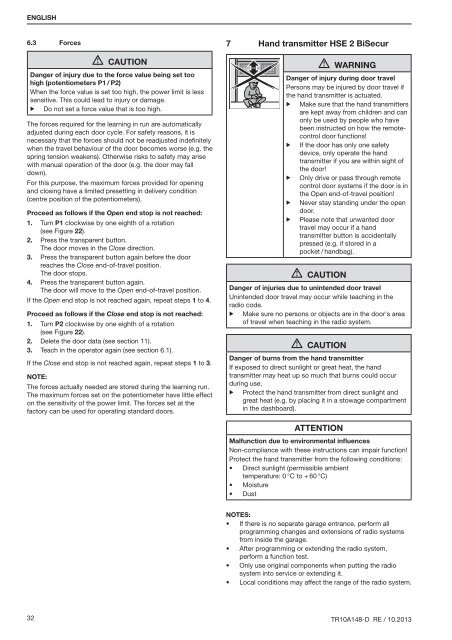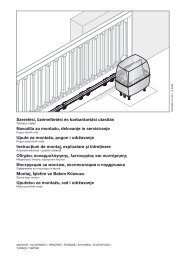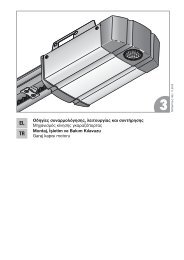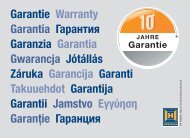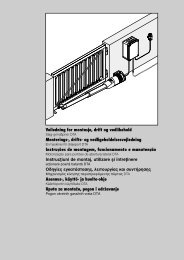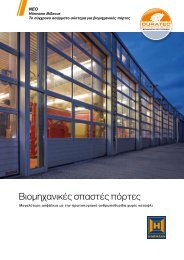ProMatic 3 - Hormann.gr
ProMatic 3 - Hormann.gr
ProMatic 3 - Hormann.gr
Create successful ePaper yourself
Turn your PDF publications into a flip-book with our unique Google optimized e-Paper software.
ENGLISH<br />
6.3 Forces<br />
CAUTION<br />
Danger of injury due to the force value being set too<br />
high (potentiometers P1 / P2)<br />
When the force value is set too high, the power limit is less<br />
sensitive. This could lead to injury or damage.<br />
▶ Do not set a force value that is too high.<br />
The forces required for the learning in run are automatically<br />
adjusted during each door cycle. For safety reasons, it is<br />
necessary that the forces should not be readjusted indefinitely<br />
when the travel behaviour of the door becomes worse (e.g. the<br />
spring tension weakens). Otherwise risks to safety may arise<br />
with manual operation of the door (e.g. the door may fall<br />
down).<br />
For this purpose, the maximum forces provided for opening<br />
and closing have a limited presetting in delivery condition<br />
(centre position of the potentiometers).<br />
Proceed as follows if the Open end stop is not reached:<br />
1. Turn P1 clockwise by one eighth of a rotation<br />
(see Figure 22).<br />
2. Press the transparent button.<br />
The door moves in the Close direction.<br />
3. Press the transparent button again before the door<br />
reaches the Close end-of-travel position.<br />
The door stops.<br />
4. Press the transparent button again.<br />
The door will move to the Open end-of-travel position.<br />
If the Open end stop is not reached again, repeat steps 1 to 4.<br />
Proceed as follows if the Close end stop is not reached:<br />
1. Turn P2 clockwise by one eighth of a rotation<br />
(see Figure 22).<br />
2. Delete the door data (see section 11).<br />
3. Teach in the operator again (see section 6.1).<br />
If the Close end stop is not reached again, repeat steps 1 to 3.<br />
NOTE:<br />
The forces actually needed are stored during the learning run.<br />
The maximum forces set on the potentiometer have little effect<br />
on the sensitivity of the power limit. The forces set at the<br />
factory can be used for operating standard doors.<br />
7 Hand transmitter HSE 2 BiSecur<br />
WARNING<br />
Danger of injury during door travel<br />
Persons may be injured by door travel if<br />
the hand transmitter is actuated.<br />
▶ Make sure that the hand transmitters<br />
are kept away from children and can<br />
only be used by people who have<br />
been instructed on how the remotecontrol<br />
door functions!<br />
▶ If the door has only one safety<br />
device, only operate the hand<br />
transmitter if you are within sight of<br />
the door!<br />
▶ Only drive or pass through remote<br />
control door systems if the door is in<br />
the Open end-of-travel position!<br />
▶ Never stay standing under the open<br />
door.<br />
▶ Please note that unwanted door<br />
travel may occur if a hand<br />
transmitter button is accidentally<br />
pressed (e.g. if stored in a<br />
pocket / handbag).<br />
CAUTION<br />
Danger of injuries due to unintended door travel<br />
Unintended door travel may occur while teaching in the<br />
radio code.<br />
▶ Make sure no persons or objects are in the door's area<br />
of travel when teaching in the radio system.<br />
CAUTION<br />
Danger of burns from the hand transmitter<br />
If exposed to direct sunlight or <strong>gr</strong>eat heat, the hand<br />
transmitter may heat up so much that burns could occur<br />
during use.<br />
▶ Protect the hand transmitter from direct sunlight and<br />
<strong>gr</strong>eat heat (e.g. by placing it in a stowage compartment<br />
in the dashboard).<br />
ATTENTION<br />
Malfunction due to environmental influences<br />
Non-compliance with these instructions can impair function!<br />
Protect the hand transmitter from the following conditions:<br />
Direct sunlight (permissible ambient<br />
temperature: 0 °C to + 60 °C)<br />
Moisture<br />
Dust<br />
NOTES:<br />
If there is no separate garage entrance, perform all<br />
pro<strong>gr</strong>amming changes and extensions of radio systems<br />
from inside the garage.<br />
After pro<strong>gr</strong>amming or extending the radio system,<br />
perform a function test.<br />
Only use original components when putting the radio<br />
system into service or extending it.<br />
Local conditions may affect the range of the radio system.<br />
32 TR10A148-D RE / 10.2013


